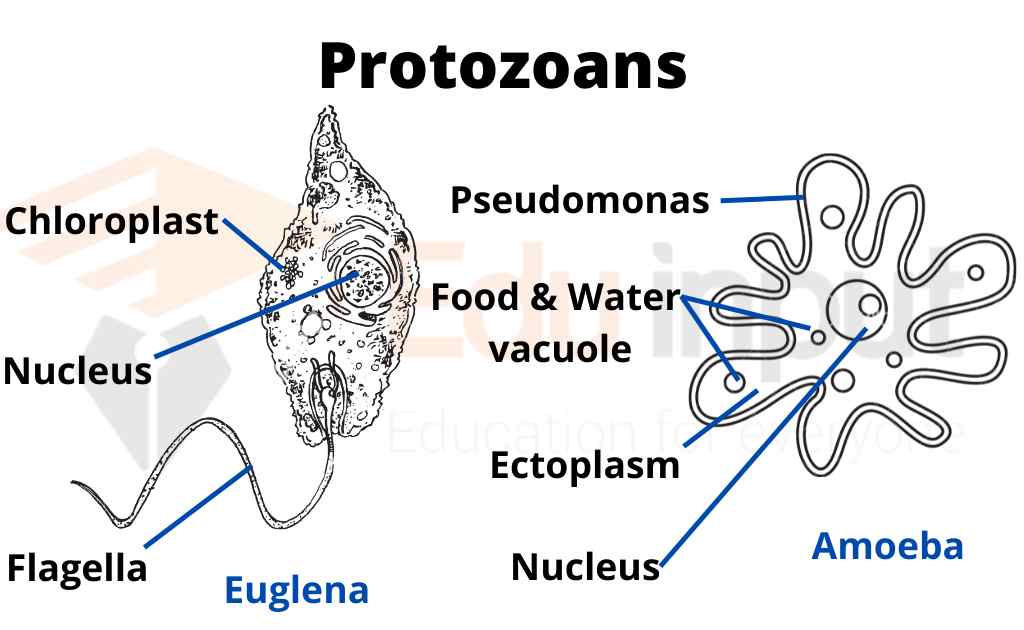Protozoa-General Structure, Characteristics, and Classification
Protozoa are eukaryotic cells and are closely related to fungi, algae, and animals. There are over 65,000 species of protozoa, making them the second largest phylum after nematodes. Protozoans are often referred to as protists.
They include amoebas, paramecia, ciliates, and flagellates.
Protozoa are eukaryotic cells that contain nuclei. They have membrane bound organelles , eg Euglena posses chloroplast.
The term protozoan comes from the Greek word meaning “first animal.” protozoans are found in nearly every environment on earth, from hot springs to saltwater pools.
General Structure of Protozoans
Protozoa are single-celled organisms that have organelles with functions similar to organs in higher animals. The plasma membrane encloses the cytoplasm and nucleus. It also covers the locomotory structures such as pseudopodia, cilia, and flagella. In most protozoa, the cytoplasm is differentiated into ectoplasm and endoplasm. The nucleus is enclosed in a membrane.

Characteristics Of Protozoan
- They have a Eukaryotic cell structure
- They are heterotrophs (depend on other organisms for food)
- They lack a thick cell wall.
- They reproduce asexually through the fission method.
- They use flagella/ cilia for locomotion.
- Their body is covered by a cuticle or pellicle
- Freshwater species have a contractile vacuole.

Nutrition in Protozoan
Protozoa are unable to make their food, and so they must ingest it instead. They do this by a process called phagocytosis, where they essentially consume their food whole. Some protozoan groups have a specialised structure called a cytostome, which helps with phagocytosis.
Locomotion in Protozoan
Most species of protozoa have either flagella, cilia, or pseudopodia for locomotion. Sporozoa, which lack any locomotory structure, instead have subpellicular microtubules to facilitate slow movement.
Reproduction in Protozoan
Asexual reproduction is the most common form of reproduction for bacteria. They multiply by binary fission, longitudinal fission, transverse fission or budding.
Types of Protozoan
There are two basic types of protozoans:
- Free-living protozoa
- Parasitic protozoans
Free-living protozoa
Free-living protozoa are a type of microorganism that exist as independent cells. These cells are defined as phagotrophic, which means that they eat other cells.
Some species of free-living protozoa form colonies when their cells unite. Many protozoa can cause disease, while others live harmlessly in the digestive tracts of animals like cows and wood-eating insects.
Example: Acanthamoeba
Parasitic Protozoans
These tiny, single-celled organisms might not look like much, but they can cause some serious problems for humans and other animals.
Parasitic protozoa are able to invade tissues and cells, leading to a range of medical outcomes. Some diseases caused by parasitic protozoa are minor, while others can be life-threatening.
Example : Enterocytozoon Bieneusi
Classification of Protozoan
Protozoa can be divided into four major classes: amoebae, ciliates, paramecia, and sporozoans. These classes are further subdivided into many orders, families, genera, and species.
Amoebae
Amoebae are unicellular organisms that move using pseudopods. Amoebae do not have flagella, but they do have cilia. Amoebae are commonly known as slime molds.
Ciliates
Ciliates are unicellular organisms with a distinct body structure. They have a unique feeding system called ciliary action. Ciliates are commonly known as seawater amoebas.
Paramecia
Paramecia are unicellular organisms characterized by a distinctive movement pattern. They move by undulating their bodies back and forth. Paramecia are commonly known as paramecia.

 written by
written by 



Leave a Reply